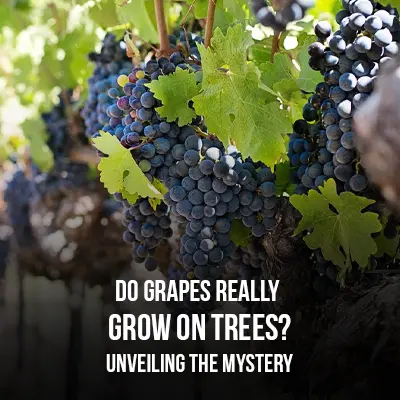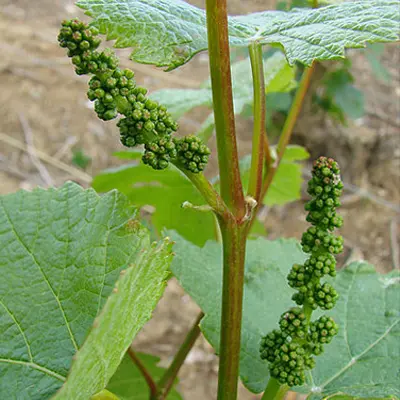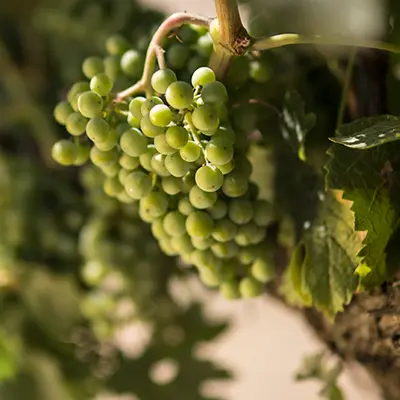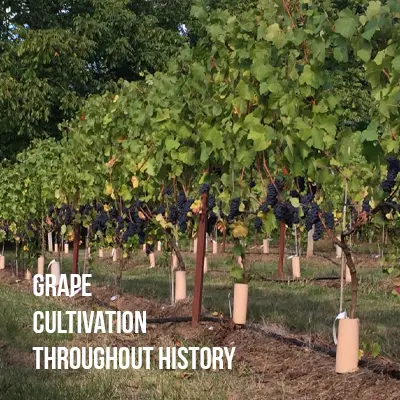
No, grapes do not grow on trees. Grapes actually grow on woody vines that are trained to climb on trellises or other support structures.
Grapes are one of the elder fruits known to man and have been cultivated for thousands of years. They are grown all over the world, in a variety of climates and soils. Grapes come in a wide range of colors, flavors, and sizes, and can be eaten fresh, dried, or made into wine.
While there are many different varieties of grapes, they all share some familiar characteristics. Grapes are high in antioxidants, vitamins, and minerals, and are a good source of fiber. Whether you’re looking to snack on a handful of fresh grapes, add them to a salad, or enjoy a glass of wine, there’s no denying the versatility and tastiness of this beloved fruit.
Grapevines: Where Do They Grow?
Grapes are one of the most widely consumed fruits worldwide, known for their juicy, sweet taste. But have you ever wondered how grapes grow and where they come from? We’ll explore grapevines, their growth habits, and where they grow.
When it comes to grapevines, they are most commonly grown in warm, sunny climates such as Mediterranean, middle eastern, and Californian vineyards. These areas provide ideal conditions for the grapes to grow, ripen and mature.
The majority of grapes are grown on vines, while a minority of grapes can be grown on trees. Vines tend to be selected due to their growth pattern and the end product they produce.
Furthermore, consider reading: Effortless Plant Care: Mastering How to Use Plant Watering Bulbs
Growth Pattern Of Grapevines, Including Roots, Shoots, And Grapes

Grapes grow in a specific pattern of root, shoot, and grape development. Understanding this growth pattern can help vineyard owners to care for their grapevines properly.
Here are the key points:
- Grapevines usually look out of the ground in late winter or early spring.
- The roots continue to grow and probe deeper into the soil, while shoots and tendrils grow toward the sun.
- During the summer grapevines continue to grow in length, and the leaves expand to absorb the sunlight.
- Next, clusters of small flowers develop into grapes, which begin to enlarge rapidly in June and July.
- By late summer, when the grapes have reached full size, they ripen, changing color, and developing their signature taste.
Difference Between Grapes Grown On Vines Versus Trees
While some grape varieties grow on trees, the majority of grapes are grown on vines for the following reasons:
- Vines allow grapes to receive more sunlight and nutrients from the soil.
- Vineyards can harvest grapes more efficiently on vines than on trees.
- The cultivation and maintenance of vines are more manageable compared to trees.
- Grapevines produce grapes year after year, whereas trees must mature before producing fruit.
Grapevines are charming plants that require specific environmental factors for optimal growth. While some grape varieties grow on trees, vineyards prefer to grow grapes on vines due to their ideal growing conditions and high-quality results.
The Botany Of Grapevines

Truth About Grapes And Trees: Uncovering The Botanical Details
Have you ever wondered if grapes grow on trees? It’s a common fallacy that grapes grow on trees like apples or oranges. In reality, grapevines are a type of climbing plant that grows on support structures like frames or fences.
Anatomy Of Grapevines, Including Stems, Leaves, And Fruit
Grapevines have complicated anatomy that is essential to their growth and grape production. Here are some key points to keep in mind:
- The stem of a grapevine is woody and permanent, with buds that develop into branches and shoots.
- Leaves are essential for photosynthesis, which provides energy for the plant to grow and produce grapes. They are also responsible for transpiration, which regulates the plant’s water usage.
- Grapes grow in groups on the vine, with each grape containing seeds and pulp.
Role Of Pruning In Grapevine Growth And How It Affects Grape Production
Pruning is a necessary practice in grapevine growth that has a direct effect on grape production. Here’s what you need to know:
- Pruning is the process of cutting back some of the plant’s growth to control its size and promote optimal grape production.
- It’s essential to prune grapevines every year to promote new growth and prevent old growth from becoming too woody and inefficient.
- Proper pruning techniques involve a balance between removing enough growth to produce new growth, but not too much that can harm the plant.
Understanding the anatomy of grapevines and the role of pruning is essential to producing high-quality grapes. By following proper pruning techniques and giving your grapevines the support they need to grow, you can enjoy a healthy, productive vineyard for years to come.
Read also: The Surprising Truth: Plants Absorb Water Through Their Leaves!
Grape Cultivation Throughout History

Do Grapes Grow On Trees?
Grapes are small and juicy fruits that grow on vines, not trees. However, did you know that in old times, grapes were grown on trees? Grape cultivation has developed over time, and there is a rich history behind it. In this section, we’ll explore the historical context of grape cultivation, discuss the evolution of grape-growing techniques over time, and highlight the transition from trees to vines in grape cultivation.
Historical Context Of Grape Cultivation
Grapes were one of the earliest crops to be domesticated, and their cultivation began over 8,000 years ago in the middle east. The ancient Egyptians and Greeks were also known to cultivate grapes and produce wine. The wine was a status symbol in ancient times, and those who could afford it drank it frequently.
Evolution Of Grape-Growing Techniques Over Time
Over the years, grape-growing techniques have evolved significantly, thanks to the continuous experimentation by winemakers. Some of the milestones in grape-growing techniques include the following:
- Introduction of trellis systems: In the 15th century, the first grape trellis system was created. This helped support grapevines and increased the clear space between vines, making more efficient use of space.
- Introduction of mechanical harvesting: In the early 1960s, machines were introduced that helped harvest grapes. This not only reduced labor costs but also improved the speed and efficiency of grape harvesting.
- The use of irrigation: In ancient times, grapevines depended solely on rainwater for their growth. However, the introduction of new irrigation techniques made grape cultivation possible in dry regions.
Transition From Trees To Vines In Grape Cultivation
Grapes were originally grown on trees in ancient times. However, winemakers later discovered that growing grapes on vines produced better crops. The transition from trees to vines in grape cultivation can be traced back to the 14th century in Europe.
Some of the reasons why vineyards substituted orchards include:
- Vines are easier to manage: Pruning grapevines is easier than pruning trees. This made vineyards easier to manage and maintain.
- Increased grape quality: Grapevines produce better quality grapes than trees, which were often used as a help to support grapevines.
- Better yield: Vines produce a significantly higher yield of grapes per unit area than trees. This made grape production more efficient.
A Timeline Of Grape Growing: From Trees To Vines
- 8,000 bc: Grape cultivation begins in the middle east.
- 800 bc: Greek and Roman civilizations cultivate grapes on a large scale.
- 1700: Grape cultivation is introduced in the United States.
- 1850: The first grapevine trellis system is created.
- 1900: Mechanical harvesting machines are introduced.
- 1960: Irrigation techniques improve grape cultivation in arid regions.
- 1970: Vines replace trees as the primary method of growing grapes.
Grape cultivation has come a long way over the years. From being grown on trees to vines, the development of grape-growing techniques has made the crop more efficient to produce. The rich history of grape cultivation is fascinating, and it’s interesting to see how far the process has come over time.
Furthermore, it is recommended to read: Do Vegetables Contain Seeds? Unveiling the Truth
Vineyard Management And Grape Quality
Optimizing Grape Quality: Vineyard Management And Trellising Techniques
Grapes are one of the most popular fruits worldwide, consumed fresh, dried, or processed into wine or juice. Grapes grow on vines and are known for their versatility and sweet taste. However, growing grapes is not as simple as planting them in a garden patch.
To produce grapes that are of good quality and high returns, proper vineyard management and trellising techniques must be employed.
Importance Of Vineyard Management In Grape Production
Vineyard management is the practice of growing grapes and involves managing vine growth and health, soil fertility, pest control, and irrigation. Proper vineyard management is essential to ensure optimal grape production. Here are some key points to consider:
- Vine growth: Pruning, training, and canopy management techniques must be used to control vine growth, promote the right balance of vine vigor, and reduce disease risk.
- Soil fertility: Test soil regularly and amend the soil as necessary to provide essential nutrients and water uptake capabilities for the vines.
- Pest control: Monitor grape pests, including viral and fungal diseases, insects, and birds. Adopt a pest control plan that uses pesticides sparingly and focuses on integrated pest management.
- Irrigation: Irrigation methods should be tailored to suit the vineyard’s location, soil, climate, and grape varietals needs.
How The Type Of Trellising System Used Affects Grape Quality And Yield
Trellising systems, or grape support systems, play a critical role in grape production. The type of trellising system used affects grape quality and yield in significant ways. Here are some key points:
- Increased yield: Proper trellising can increase yield by increasing sun exposure, airflow, and managing vine canopy.
- Improved quality: Proper trellising can improve grape quality by ensuring that grapes receive optimal sun exposure and airflow, leading to better sugar and acid ratios and disease resistance.
- Trellising options: Popular trellising options have the VSP (vertical shoot positioning), Scott-henry, and lyre systems. Vsp is the most widely used, and it involves training the vine to grow vertically with two to three shoots per wire for easy management and better air and sunlight circulation.
Role Of Grape Varietals In Grape-Growing
Grape varietals, or types of grapes, differ in their growing requirements, fruit flavor, and characteristics. Here are some key points:
- Climate: Different grape varietals require different climates to grow successfully. For example, cabernet sauvignon thrives in a warm climate, while riesling is best grown in a cooler climate.
- Soil composition: Different grape varietals grow best in varying soil types. Pinot noir grows well in soils with high amounts of clay, while zinfandel does well in sandy soils.
- Flavor profile: Different grape varietals have different fruit flavors and characteristics, which can vary depending on climate and soil conditions.
Optimizing grape quality demands proper vineyard management techniques and trellising systems, and understanding the unique grape varietals’ growing requirements. By implementing these practices, grape growers can produce high-quality grapes, whether for personal consumption or commercial sale.
Frequently Asked Questions Of Do Grapes Grow On Trees
What Is The Growth Habit Of Grape Plants?
Grapes grow in a vine-like structure that typically sprawls across support structures such as trellises or fences, but they can also be grown as a tree form.
Do Grapes Grow On Trees Or Bushes?
Grapes can be grown on trees, but it’s not their typical growth habit. They are primarily grown as sprawling vines that are prepared to grow on trellises or fences.
What’s The Difference Between Grape Tree And Grapevine?
A grapevine grows in a vine-like structure, whereas a grape tree is a grapevine that has been trained to grow into a tree-like form. Both produce grapes.
How Long Does It Take For A Grapevine To Produce Fruit?
It takes about three years for a grapevine to produce fruit after it has been planted. However, the quality and quantity of grapes produced by a vine can increase significantly as it reaches maturity.
What Type Of Soil Do Grapevines Need To Grow Properly?
Grapevines prefer well-draining soils that are rich in organic matter, with a ph between 5. 5 and 7. 0. Ideally, the soil should be deep, fertile, and free from any obstacles that could impede root growth.
Conclusion
As we come to the end of this blog post, we can conclude that grapes do not grow on trees, contrary to popular thought. Grapes are grown on vines that are supported by trellises, fences, or other structures. We learned about the history of grape cultivation and how it has evolved over time, with new techniques being developed to optimize grape growth and yield.
Grapes are a fascinating fruit that holds great cultural, economic, and ecological value. We encourage you to explore the world of grape cultivation and discover all the amazing things that grapes have to offer. Thank you for joining us on this journey, and we look forward to sharing more insights and discoveries with you in the future.
